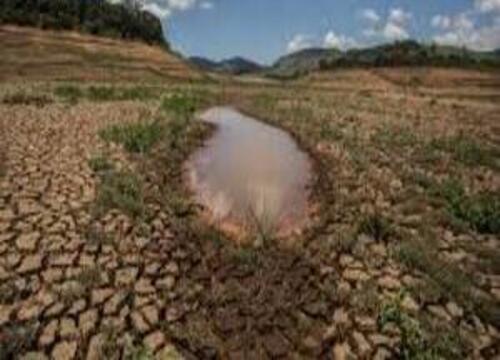
Rainfall deficit-causing El Nino likely in coming months: why India should worry
The forecasts should be taken as cautionary, says Sivananda Pai, former director of India Meteorological Department

On March 1, the World Meteorological Organisation (WMO) warned that a warming El Nino event may develop in the coming months with a 55 percent chance of occurrence in June-August when India gets most of its monsoon rainfall. El Nino has a high correlation with warmer summers and poor monsoon rains in India. Earlier, on February 9, the Climate Prediction Center (CPC) of the National Oceanic and Atmospheric Administration (NOAC) forecast a 49 percent probability of El Nino in June-August. On February 23, Columbia University’s International Research Institute for Climate Change and Society said all its 18 dynamic models and all except one of the eight statistical models indicated a 56-59 percent probability of El Nino during those months.

El Nino has happened about 30 times since 1900. Since the forecast probability is higher than the climatological probability of El Nino, the monsoon season would likely be in deficit, Sivananda Pai, a weather forecaster, told The Federal in a video interview. Pai led the monsoon-forecasting team at the India Meteorological Department (IMD) till his deputation in 2021 to the Institute for Climate Change Studies, Kottayam, as director.
The “predictability” barrier
El Nino occurs when sea surface temperature over a six million sq. km area in equatorial Pacific, just west of the International Dateline is 0.5 degrees centigrade or more higher than the average of the previous three decades.
Also read: China wants to reduce Indias influence in Indian Ocean region, say papers submitted at DGPs meet
The past three years have been good monsoon-wise. There was normal rainfall in 2021, while 2022, 2020 and 2019 saw excess rainfall. The year 2018 was among ten in the last two decades that had deficit rainfall. India is in a multi-decade phase or “epoch” of rainfall deficits, according to Pai, so there is a likelihood of the coming monsoon season being in deficit.

But the “predictability barrier” of the spring season (March-April-May) will have to be crossed for a clearer picture, the three organisations mentioned above said. El Nino (or its opposite La Nina, defined by unusually cooler waters in the eastern equatorial Pacific) are yearlong events that begin in spring (March, April, May), peak in winter and end in the next spring. Predictions made at the beginning or end of the cycle are not that strong, Pai said.
In 2019, for instance, there was El Nino in May, June and July, but it was at the end of a cycle that had begun the previous year. It delayed the onset of southwest monsoons in Kerala and June rainfall countrywide was in deficit by 67 percent. But the weakening of El Nino conditions and the emergence of positive Indian Ocean Dipole (IOD) in July led to increased rainfall activity from the last week of July. Overall precipitation during the seasons exceeded the long period average (LPA) by 10 percent.
El Nino – and La Nina – occur naturally. But they are taking place against a background of human-induced climate change, which is increasing global temperatures, affecting seasonal rainfall patterns, and making our weather more extreme, WMO said.
Madden Julian Oscillation
There are countervailing influences, too. Positive IOD or warmer western Indian Ocean surface temperature compared to the eastern part, at the Equator, could offset the negative impact of El Nino. Currently, the IOD forecast is neutral for the monsoon season. But it has a shorter alert period and becomes apparent closer to its occurrence in July, August. It weakens by November.
For these reasons, the Met Department makes two monsoon forecasts — one in April and the other in May or early June. It uses five predictors: sea surface temperature gradient between north Atlantic and north Pacific; equatorial south Indian Ocean surface temperature; East Asia mean sea level pressure; northwest Europe land surface air temperature and equatorial Pacific warm water volume.
Also read: A 60-hour journey to ancient Greek records to understand the indian Ocean
Within the monsoon season there are variations brought about, say, by an eastward moving disturbance of clouds, rainfall, winds and pressure that traverses the planet at the tropics and returns to its initial starting point in 30-60 days. This is how the website www.climate.gov describes what Pai called the Madden Julian Oscillation (MJO). It accounts for intra-seasonal tropical climate variability, which varies from week to week and is most prominent over the Indian and Pacific Oceans.
Even if El Nino were to happen, it would not indicate how much below normal the rainfall will be. In 2009, the southwest monsoon rainfall deficit was 26 percent and the worst since 1972. The sea surface temperature difference at the El Nino area in June, July and August that year was 0.5 degrees centigrade. But in 2015, when the temperature difference was 1.5 degrees centigrade, the rainfall deficit in India was 14 percent.
An oceanic phenomenon
Monsoon is an atmospheric phenomenon; El Nino is oceanic. There is a difference between what happens in the ocean and in the atmosphere. In years when there is strong El Nino coupling, it will have a strong impact on the atmosphere above the Pacific and on monsoons in India. Regional factors like land surface temperature and IOD also influence. If they are favourable, the link between El Nino and monsoon will become weaker. If they impact negatively, the coupling will become stronger.
As monsoon is a complicated phenomenon, El Nino forecasts should be taken as cautionary. Farmers must rely on the Met department’s extended range predictions of two-week weather and short-range weekly forecasts.
India is currently in an anxiety zone. Maximum February temperatures in wheat-growing Punjab and Haryana were 3-5 degrees higher than normal, the Met department said. Last year around this time, warmer-than-usual March temperatures when the wheat crop was at the grain-filled stage had caused a wheat output loss of 4.5 million tonnes in these states. It was made up by a corresponding increase in output in Madhya Pradesh. But wheat stocks are running low. As of February 1, they were 55 percent compared to the level at the same time a year ago. Rice stocks are 64 percent of last year’s level. India will be in a tight spot if poor rabi wheat harvest is aggravated by foodgrain production losses in the monsoon season. But a committee of agricultural experts, set up by the agriculture ministry, assessed at its meeting on March 2 that the wheat crop in north-west India was “normal,” and much of it was unlikely to be affected by heat conditions in March, the Press Information Bureau said.

